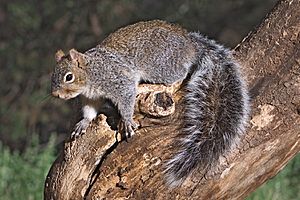Arizona gray squirrel facts for kids
Quick facts for kids Arizona gray squirrel |
|
|---|---|
 |
|
| Conservation status | |
| Scientific classification | |
| Genus: |
Sciurus
|
| Species: |
arizonensis
|
| Subspecies | |
|
|
 |
|
| Arizona gray squirrel range | |
The Arizona gray squirrel (Sciurus arizonensis) is a type of tree squirrel. It lives only in certain parts of eastern Arizona and northern Mexico. You can find them in canyons and valleys. They like forests with trees that lose their leaves, or mixed forests.
Sadly, these squirrels are losing their homes because of habitat loss. Another big squirrel in their area is Abert's squirrel. But Abert's squirrels have fuzzy ear tufts and live in pine forests. Arizona gray squirrels look and act like other gray squirrels. But guess what? They are actually closer relatives to the fox squirrel!
Contents
What Do Arizona Gray Squirrels Look Like?
The Arizona gray squirrel is part of the rodent family, just like mice and rats. It's a member of the squirrel group called Sciuridae.
You can tell an Arizona gray squirrel apart from an Abert's squirrel. The Arizona gray squirrel has a longer, flatter head. Its nose area is also wider. It has only one special tooth called a molar, while Abert's squirrels have two.
Arizona gray squirrels also have smaller ears. They do not have the ear tufts that Abert's squirrels have. Look closely at the underside of their tail. You might see a red or black stripe!
Sometimes, male and female Arizona gray squirrels are different sizes. In some groups, males are bigger. In other groups, females are larger.
Where Do Arizona Gray Squirrels Live?
The Arizona gray squirrel, or Sciurus arizonensis, lives in parts of Arizona, New Mexico, and Sonora, Mexico. They prefer to live in mountains at middle elevations. They especially like areas near rivers or streams. These places are called riparian habitats. They usually choose broadleaf riparian habitats.
The area where Arizona gray squirrels live in New Mexico has not changed much. It has not gotten bigger or smaller recently. However, their numbers have gone down in some places. This is because they are losing their homes. Also, Abert's squirrels have moved into some of their areas. Sometimes, Abert's squirrels take over the food and space.
What Do Arizona Gray Squirrels Eat?
The Arizona gray squirrel mainly eats pine cones, acorns, and other nuts. They also enjoy eating seeds and berries.
How Do Arizona Gray Squirrels Have Babies?
The Arizona gray squirrel's diet changes a lot. This means their reproduction rates also change from year to year. Not all female squirrels have babies every year.
Arizona gray squirrels usually mate when flowers are blooming. Flowers are a great source of energy for them. Having babies takes a lot of energy. So, mating at the right time helps both the parents and the babies survive.
The best time to mate can be different for males and females. It depends on changes in their habitat. Their environment can change a lot throughout the year.
Male and female squirrels have areas where they live. These areas often overlap. When conditions are good for mating, their living areas get bigger. This means they overlap even more.
People have seen many male squirrels chasing one female during mating season. This is called a mating chase.
To help Arizona gray squirrels survive, we need to protect their nesting spots. This means keeping large trees with thick canopies. These trees give them food and keep them safe from predators.


